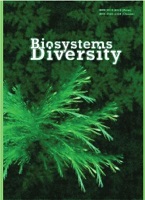Evaluation of grain yield performance and its stability in various spring barley accessions under condition of different agroclimatic zones of Ukraine
Evaluation of grain yield performance and its stability in various spring barley accessions under condition of different agroclimatic zones of Ukraine
Author(s): V. M. Hudzenko, N. M. Buniak, L. V. Tsentylo, O. A. Demydov, I. V. Fedorenko, M. V. Fedorenko, V. A. Ishchenko, H. M. Kozelets, L. V. Khudolii, S. O. Lashuk, N. O. SyplyvaSubject(s): Agriculture, Environmental Geography, Environmental interactions
Published by: Дніпропетровський національний університет імені Олеся Гончара
Keywords: Hordeum vulgare L.; genotype by environment interaction; variability; adaptability; homeostaticity; GGE biplot; AMMI;
Summary/Abstract: Two extremely urgent problems of biological and agronomic research nowadays are ensuring an optimal balance between usage of natural resources to meet rapidly growing needs for food production and preservation of biodiversity. It is also important to extend the genetic diversity of the main crop varieties in agroecosystems. At the same time, modern varieties should be characterized by a combination of high yield and preserving yield stability under variable conditions. Solving the outlined tasks requires comprehensive research and involvement in breeding process of the genetical diversity concentrated in genebanks of the world. Barley (Hordeum vulgare L.) is one of the most important crops that satisfy the various needs of humanity. In respect to this, in 2020–2022, a multi-environment trial was conducted in three agroclimatic zones of Ukraine (Forest-Steppe, Polissia, and Northern Steppe). We studied 44 spring barley collection accessions of different ecological and geographical origin, different subspecies and groups of botanical varieties which were obtained from the National Center for Plant Genetic Resources of Ukraine. Statistical indices (Hom, Sc) and graphical models (GGE biplot, AMMI) were used to interpret the yield performance and its stability. Both individual ecological sites in different years and combinations of different sites and years of trials were characterized for productivity, discriminating power and representativeness. The environments differed quite strongly among themselves in terms of these indicators. It was established that most of the genotypes were characterized by higher adaptability to individual environmental conditions (stability in different years), compared to adaptability for all agroclimatic zones (wide adaptation). A strong cross-over genotype by environment interaction was found for most studied accessions. Nevertheless, both genotypes with very high stability in only one agroclimatic zone (Amil (UKR), Gateway (CAN)) and genotypes with a combination of high adaptability to one or two ecological niches and relatively higher wide adaptability (Stymul (UKR), Ly-1064 (UKR), Rannij (KAZ), Shedevr (UKR), and Arthur (CZE)) were identified. There were also the accessions which did not show maximum performance in the individual sites, but had relatively higher wide adaptability (Ly-1059 (UKR), Ly-1120 (UKR), Diantus (UKR), and Danielle (CZE)). In general, the naked barley genotypes were inferior to the covered ones in terms of yield potential and wide adaptability, but at the same time, some of them (CDC ExPlus (CAN), CDC Gainer (CAN), and Roseland (CAN)), accordingly to the statistical indicators, had increased stability in certain ecological sites. Among naked barley accessions relatively better wide adaptability according to the graphical analysis was found in the accession CDC McGwire (CAN), and by the statistical parameters CDC ExPlus (CAN) was better than standard. The peculiarities of yield manifestation and its variability in different spring barley genotypes in the multi-environment trial revealed in this study will contribute to the complementation and deepening of existing data in terms of the genotype by environment interaction. Our results can be used in further studies for developing spring barley variety models both with specific and wide adaptation under conditions of different agroclimatic zones of Ukraine. The disitnguished accessions of different origin and botanical affiliation are recommended for creating a new breeding material with the aim of simultaneously increasing yield potential and stability, as well as widening the genetic basis of spring barley varieties.
Journal: Biosystems Diversity
- Issue Year: 30/2022
- Issue No: 4
- Page Range: 406-422
- Page Count: 17
- Language: English

